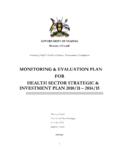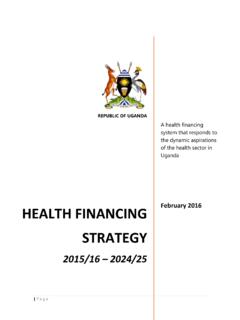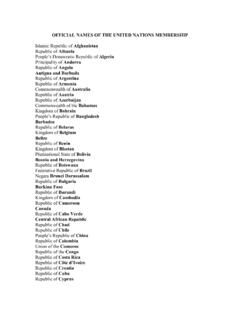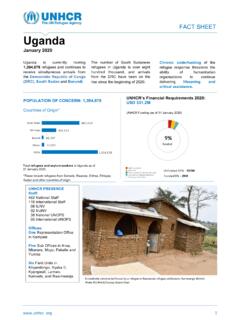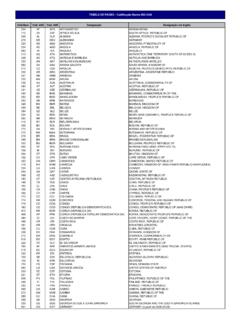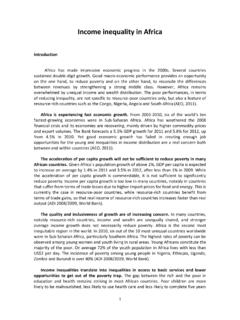Transcription of Republic of Uganda
1 I Republic of Uganda Ministry of Health Uganda National eHealth Strategy 2017 - 2021 ii Foreword The Ugandan healthcare system, through its ongoing health sector reforms, aims to improve health outcomes. As part of these reforms, the Ministry of Health (MOH) developed the Health Sector Development Plan (HSDP) 2015/16 - 2019/20 to address the key challenges facing Uganda s health system, set out priorities and key areas on which to focus health investment in the medium term, for both public and private partners, in order to optimally contribute to the attainment of both the health sector goals and the national goals as outlined in the National Development Plan II. Although implementation of HSSP III promised to produce many positive results, realizing the best outcomes in the face of increasing pressures on the healthcare system requires a fundamental transformation in the way health care is delivered and managed.
2 The Ministry recognizes the potential of information and communication technology (ICT) in transforming healthcare delivery by enabling information access and supporting healthcare operations, management, and decision making. However, the Ugandan health sector is characterized by a fragmented landscape of ICT pilot projects and numerous data and health information system (HIS) silos with significant barriers to the effective sharing of information between healthcare participants. Although the government, partners, and private institutions are continuing to invest in various ICT initiatives, without some form of a national plan and coordination, there is a real risk of continued duplication, ineffective expenditure, and the creation of new solutions that cannot be integrated or scaled across the continuum of care.
3 To form a national plan and communication, the MOH developed a National eHealth Policy (2013), a National eHealth Strategy (2013), and subsequently a draft National eHealth Policy (2016) to guide the use of ICT in supporting health sector transformation. As part of these processes, the Ministry, through an eHealth Technical Working Group (eHealth TWG) supported by United Nations Children s Fund (UNICEF) and World Health Organization (WHO), conducted a series of national consultations that included health sector professionals, partners, faith-based organizations, Government, non-governmental organizations (NGOs), and other stakeholders. In 2016, the Ministry, through technical and financial support from UNICEF and WHO under the stewardship of the eHealth TWG reviewed the draft eHealth Policy and strategy, seeking areas for improvement.
4 The review process also followed a participatory approach driven by HSDP strategic objectives. The National eHealth Policy and Strategy provide an appropriate basis to guide the development of eHealth in Uganda . It adopts enterprise architecture (EA) - driven development approach to developing eHealth capabilities: Leverage what currently exists in the Ugandan eHealth landscape. Understand what the new components are and where they fit in existing structures. Define information structures to fit current needs and to support anticipated ones. Demonstrate how technology and resource constraints dictate both what is feasible and the path forward. The implementation of this eHealth policy and strategy will accelerate the ongoing reforms and sustain the gains witnessed in the sector since 2015, when the sector started the implementation of HSDP.
5 In addition, the policy and strategy will address some of the key challenges experienced iii during HSDP, that include a shortage of qualified healthcare professionals at all levels of the health system; epidemics such as HIV/AIDS, tuberculosis (TB), and malaria; and limited access to health facilities and health professionals due to poor infrastructure, inefficiencies of the healthcare system, poverty, and ignorance. The National eHealth Policy and Strategy will deliver the eventual benefit of a safer, high-quality, equitable, efficient, and sustainable health system that is equipped to respond to emerging health sector cost and demand pressures. The Ugandan healthcare system enhancements will also drive stronger workforce productivity that is vital to Uganda s long-term economic development.
6 The National eHealth Policy and Strategy is applauded as a useful guide to the next steps for Uganda in its eHealth journey. The Policy and Strategy are pragmatic, balances different priorities, and will help to lead Uganda toward the delivery of a safer, better connected, and more sustainable healthcare system. Dr. Jane Ruth Aceng Minister of Health iv Table of Contents Foreword .. ii Table of Contents .. iv Acknowledgements .. 1 List of Acronyms and Abbreviations .. 1 Definition of Key Terms .. 4 List of Tables .. 7 List of Figures .. 7 EXECUTIVE SUMMARY .. 9 1 Introduction .. 11 eHealth Background .. 11 Methodology of developing the eHealth Strategy .. 11 2 Strategic Context for eHealth.
7 12 The International Perspective .. 12 The Uganda Healthcare System .. 14 Justification of eHealth in Uganda .. 15 3 Situation Analysis .. 16 Uganda eHealth Situation Analysis .. 16 Leadership and Governance of 16 eHealth Enterprise Architecture, Interoperability and Standards .. 16 v eHealth Services, Information Sharing and Data Management .. 16 Infrastructure .. 17 eHealth Information Assurance .. 18 Ethics .. 18 Human Resources and Capacity Building .. 19 Mainstreaming Special Interest Groups .. 19 Research, Innovation and Development .. 19 eHealth Investment .. 20 Stakeholder Engagement, Collaborations, Advocacy and SMART Partnerships .. 20 Business Process Re-Engineering .. 21 Legal and Regulatory Framework for eHealth.
8 21 eHealth SCOT Analysis .. 21 4 Aspirations of the eHealth Strategy .. 24 Scope .. 24 Vision .. 24 Mission .. 24 Goal .. 24 24 Strategy Guiding Principles .. 25 5 Strategic Direction/Focus .. 26 6 eHealth Strategic Pillars .. 30 Leadership and Governance of eHealth .. 30 eHealth Enterprise Architecture, Interoperability and Standards .. 32 eHealth Services, Information Sharing and Data Management .. 34 Infrastructure .. 44 Ethics .. 47 eHealth Information Assurance .. 48 Human Resources and Capacity Building .. 50 Mainstreaming Special Interest Groups .. 52 Research, Innovation and 53 eHealth 55 Stakeholder Engagement, Collaborations, Advocacy and SMART Partnerships .. 58 Change, Adoption, Business Process Re-Engineering and Transitioning.
9 59 vi Legal and Regulatory Framework .. 61 7 Implementation .. 62 Roadmap and Action Plan .. 63 Projects and Prioritization .. 65 Funding and Budget .. 65 Funding Model .. 65 Budget .. 67 Monitoring and Evaluation .. 69 The Proposed Monitoring and Evaluation Process .. 70 Governance and Management .. 72 Critical Success Factors .. 77 Sustainability .. 78 Sustainability Planning .. 78 Sustainability Planning Guideline .. 78 Appendices .. 81 Appendix A) Phased Implementation .. 81 Appendix B) Detailed Costing and Budget .. 96 Appendix C) Monitoring and Evaluation Matrix .. 96 Appendix D) Governance and Management .. 97 Existing Governance Structures .. 97 eHealth Ideal Governance and Management Responsibility Matrix.
10 99 Proposed Governance and Management .. 100 Appendix E) Enterprise Architecture Ideal Situation .. 113 Appendix F) Priority Medical Institutions and Facilities Connection to the NBI .. 114 Appendix G) eHealth Pilot Solutions .. 116 Appendix H) Key Stakeholders .. 117 1 Acknowledgements List of Acronyms and Abbreviations AIN Alien Identification Number BC Business Continuity CIS Clinical Information System CPD Continuing Professional Development CSO Civil Society Organization DGHS Director General of Health Services DR Disaster Recovery EAC East African Community EGI e-Government Infrastructure HEA-IF Health Enterprise Architecture and Interoperability Framework EHR Electronic Health Record EMR Electronic Medical Record eTWG eHealth Technical Working Group GOe Global Observatory for eHealth HCI Health Centre 1 HCII Health Centre 2 HCIII Health Centre 3 HCIV Health Centre 4 HDPs Health Development Partners HIS Health Information System HMIS Health Management


